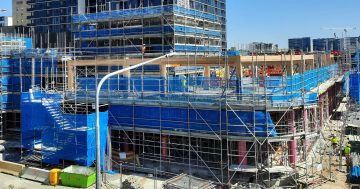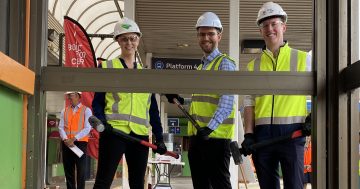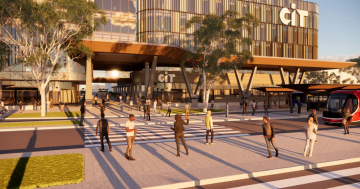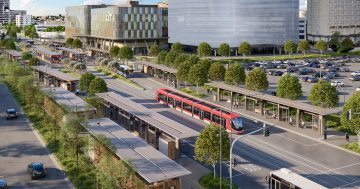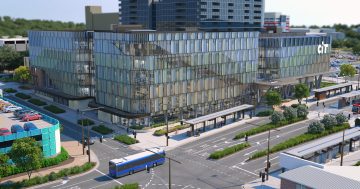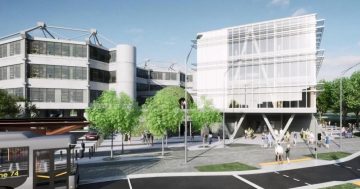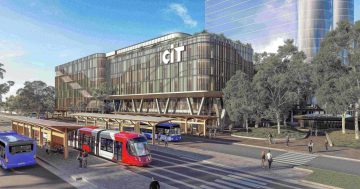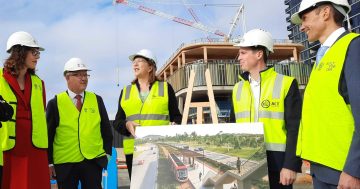
Chris Steel and Lendlease general manager Ben Owen at the Woden CIT construction site. Photo: Ian Bushnell.
Construction has started on the Woden CIT building after the approval of the development application and the installation of the project’s first crane.
Minister for Transport and City Services Chris Steel was on site on Tuesday (22 August) with Lendlease general manager Ben Owen to mark the milestone. Mr Steel said the project was on track to be completed in time for 6500 students and staff to move in during the second half of 2025 despite the labour and supply chain issues bedevilling the construction sector.
Mr Steel said the project, which had created 500 jobs already, including for local apprentices, would be transformational for the Woden Town Centre, where thousands of new residents will make their home in coming years.
He said the government had taken community feedback on board to improve weather protection, connections to nearby active travel routes, safety, precinct activation and building in more green space.
“On weather protection, we have responded by adding a larger entry canopy, as well as increasing the overall covered area around the main CIT building by creating a 2.7-metre-wide colonnade linking the interchange and main campus building,” Mr Steel said.
He added there would also be further announcements on greater weather protection in the new transport interchange.
He confirmed that the much-criticised proposed north-south connection between Bowes and Bradley streets will go ahead as a shared, low-speed road.
Mr Steel said the government had listened to feedback wanting better passive surveillance, pick up and drop off points, and better access for people with a disability and for the existing businesses.
“We know that providing a shared connection will create a safer place. It will be a place where businesses can use the road to access their premises, including for delivery.”
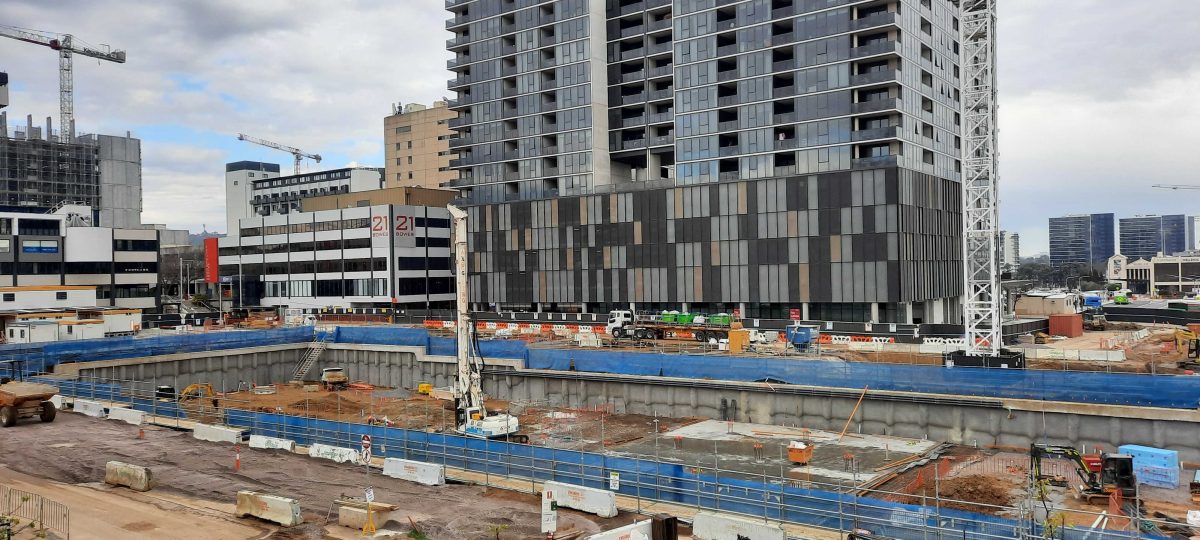
The Woden CIT construction site. The first crane is up and the work is ready to start on the actual building. Photo: Ian Bushnell.
Public Transport Association of Canberra chair Ryan Hemsley said the road as now proposed was a good outcome and reflected his organisation’s recommendations during consultation.
“When this road was originally announced it was just a road with all the usual problems that are associated with driving through an area where there is no road,” he said.
“Subsequent detail design stages have produced a road that has far more of a shared zone feel.
“It does provide some north-south connectivity to ensure that the bus connections through Easty Street from the new layover north of the interchange are able to flow smoothly and maintain bus reliability while also making sure that this place … has got good amenities and provides good east-west axis from the Woden Library through to the Woden Town Park.”
Mr Steel said the campus would aim for a 30 per cent canopy to ensure there was much more greenery than there was now in what he admitted was a concrete jungle on Woden’s east side. There would be more landscaping planting and trees, as well as shelter.
“That was feedback from the community on the building itself to make sure that people can still scurry through into Westfield, into the town square if it is raining,” Mr Steel said.
“It will be a much better place for people and it will have a campus feel to make sure students want to spend time here studying, but also for the broader public to come in as well.”
Spaces within the building itself include a new large multi-purpose hall that will be able to be booked out by the community and used by students in the CIT for their programming as well.
Mr Steel said the project would future-proof the interchange by making it light rail ready.
“We’re building stops now ready for light rail in the future so that we don’t have to tear up the interchange again when we put the light rail through onto Callam Street,” he said.
“This is really a future-proof design of the new interchange that will provide excellent public transport, infrastructure and future services to this growing region.”
Mr Owen said Lendlease was confident the project would be finished by 2025.
He said the company had focussed the local supply chain and local workforce to mitigate construction risks.
“One of the advantages of this project is we have been involved in the project for quite a while now and that has allowed us to identify the critical wait time items that present the most risk, and place early orders in collaboration with the Territory to mitigate those risks to ensure the materials arrive on time,” he said.
“It is really full steam ahead for the construction of the structure.”
Mr Steel said that the move from CIT Reid would allow UNSW to start work on its master planning to deliver a campus in the heart of Canberra.












